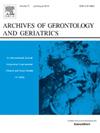Dynapenic abdominal obesity and chronic kidney disease: Results from a nationwide prospective cohort study of middle-aged and older adults in China
IF 3.5
3区 医学
Q2 GERIATRICS & GERONTOLOGY
引用次数: 0
Abstract
Introduction
The relationship between dynapenic abdominal obesity (D/AO) and chronic kidney disease (CKD) remains underexplored, particularly among Chinese middle-aged and older adults. This study aimed to address this gap by examining the association between these conditions in a specific population.
Method
We conducted a prospective analysis utilizing two waves (2011 and 2015) of data from 5932 participants aged ≥45 years in the China Health and Retirement Longitudinal Study (CHARLS). Three logistic regression models with covariate adjustment were employed to examine the longitudinal association between D/AO and CKD progression. To strengthen the validity of our results, rigorous sensitivity analyses and subgroup analyses were systematically conducted to assess the robustness of the observed primary association between D/AO and CKD.
Results
After adjusting for all covariates, D/AO was associated with a significantly increased risk of CKD (OR, 1.57; 95 % CI, 1.03–2.35). In the subgroup analyses, middle-aged adults with D/AO exhibited a significantly higher incidence of CKD, while showing no significant difference in older populations. Subgroup analyses revealed middle-aged adults with D/AO was associated with a significantly increased risk of CKD (OR, 2.40; 95 % CI, 1.14–4.59; p = 0.01), whereas older adults showed no statistically significant association (OR, 1.56; 95 % CI, 0.96–2.46; p = 0.06).
Conclusion
This prospective cohort study demonstrates that D/AO conferred elevated CKD risk in Chinese middle-aged adults, while showing no significant association in older populations. These findings highlight the need for interventions aimed at improving muscle strength and reducing abdominal adiposity in CKD prevention strategies and public health policies.
动力性腹部肥胖和慢性肾脏疾病:来自中国中老年人全国前瞻性队列研究的结果
动态腹部肥胖(D/AO)与慢性肾脏疾病(CKD)之间的关系仍未得到充分研究,特别是在中国中老年人群中。本研究旨在通过在特定人群中检查这些条件之间的关联来解决这一差距。方法对中国健康与退休纵向研究(CHARLS)中5932名年龄≥45岁的参与者(2011年和2015年)的数据进行前瞻性分析。采用三种具有协变量调整的logistic回归模型来检验D/AO与CKD进展之间的纵向关联。为了加强我们结果的有效性,我们系统地进行了严格的敏感性分析和亚组分析,以评估所观察到的D/AO与CKD之间主要关联的稳健性。在对所有协变量进行调整后,D/AO与CKD风险显著增加相关(OR, 1.57;95% ci, 1.03-2.35)。在亚组分析中,患有D/AO的中年人CKD发病率明显较高,而在老年人群中没有显着差异。亚组分析显示,患有D/AO的中年人患CKD的风险显著增加(OR, 2.40;95% ci, 1.14-4.59;p = 0.01),而老年人无统计学意义的相关性(OR, 1.56;95% ci, 0.96-2.46;P = 0.06)。结论:该前瞻性队列研究表明,D/AO会导致中国中年人CKD风险升高,而在老年人中无显著相关性。这些发现强调了在CKD预防策略和公共卫生政策中需要采取旨在提高肌肉力量和减少腹部脂肪的干预措施。
本文章由计算机程序翻译,如有差异,请以英文原文为准。
求助全文
约1分钟内获得全文
求助全文
来源期刊
CiteScore
7.30
自引率
5.00%
发文量
198
审稿时长
16 days
期刊介绍:
Archives of Gerontology and Geriatrics provides a medium for the publication of papers from the fields of experimental gerontology and clinical and social geriatrics. The principal aim of the journal is to facilitate the exchange of information between specialists in these three fields of gerontological research. Experimental papers dealing with the basic mechanisms of aging at molecular, cellular, tissue or organ levels will be published.
Clinical papers will be accepted if they provide sufficiently new information or are of fundamental importance for the knowledge of human aging. Purely descriptive clinical papers will be accepted only if the results permit further interpretation. Papers dealing with anti-aging pharmacological preparations in humans are welcome. Papers on the social aspects of geriatrics will be accepted if they are of general interest regarding the epidemiology of aging and the efficiency and working methods of the social organizations for the health care of the elderly.

 求助内容:
求助内容: 应助结果提醒方式:
应助结果提醒方式:


